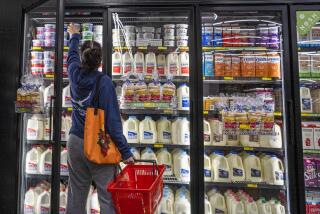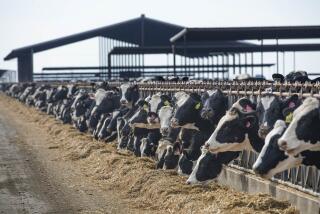Despite Bad Report, Milk Still Does a Body Good : Health: Some doctors are sour on the calcium-rich beverage, citing a link to diabetes. But most experts say children should continue to drink up.
- Share via
So, what did your mother always tell you? “Drink your milk,” right?
And she admonished you with good reason, nutrition experts say: Milk is rich in protein and calcium. It’s a traditional part of young Americans’ diet. It’s great with cookies.
Why, then, is milk getting a bad rap these days?
The controversy began earlier this year when some experts cautioned that children under 1 should not consume whole cow’s milk. One highly publicized study has linked milk with the onset of juvenile diabetes. And Dr. Benjamin Spock, the esteemed child expert, has joined an advocacy group that criticizes giving milk to children.
But is milk bad for children and teen-agers?
No, say the vast majority of experts, adding that most negative reports have been either misinterpreted by the public or are simply untrue. They contend children should consume three or four servings a day of milk or other dairy products, as recommended by the government.
Nevertheless, these experts admit, there is nothing magical about milk. It is primarily recommended as a source of calcium--and calcium can be obtained from such other foods as broccoli, kale or salmon.
In addition, nutritionists still disagree over what kind of diet is best for children’s long-term health.
“We are quite a long way from making hard and fast recommendations when it comes to children’s diets and their long-term health,” says Dr. Ronald Kleinman, a Harvard University pediatrician, at a recent American Dietetic Assn. meeting on children’s nutrition.
But until more is known, he says, drink your milk.
“You have to have a very good reason to warn people off dairy products when they are such a good source of what children need and want,” Kleinman says. “Dairy products are a mother lode to growing kids.”
Some confusion may have inadvertently stemmed from a report released last summer by the American Academy of Pediatrics’ committee on nutrition, of which Kleinman was chairman.
That statement defined what doctors see as optimal nutrition for children under 1, recommending breast-feeding for the first six months and supplementary solid foods in the second six months. Commercially prepared, iron-fortified formula is recommended as an alternative to breast milk, the committee said.
Babies of this age should not be given whole cow’s milk because of the risks of iron deficiency, Kleinman says.
But Kleinman and others maintain that the committee’s findings were twisted by the Physicians Committee for Responsible Medicine, an advocacy group, to promote the idea that milk is bad for all children.
The group, which includes Spock, announced in September that it wants to alert parents about the “health risks” of milk.
“Our position is the same as the academy’s on consuming cow’s milk in the first year of life,” Dr. Neal Barnard, the organization’s president, said in a recent interview. “However, I would further add that parents ought to be warned about the health risks of milk, including formula, for older kids.”
According to Barnard’s group, milk is high in fat; low in iron; a cause of colic, indigestion and allergies, and a link to the development of diabetes.
“I would call milk perhaps the most unhealthful vehicle for calcium that one could possibly imagine, which is the only thing people really drink it for,” Barnard says. “But whenever you challenge existing dogma . . . people are resistant.”
The group did encounter resistance--and quickly. It was soundly rebutted by the California Dietetic Assn., the Center for Science in the Public Interest, the University of California Cooperative Extension Service and the California departments of Health Services, Food and Agriculture.
Even Spock, 89, later softened his stance, saying he meant only babies under 1 year old should not consume whole cow’s milk.
“Milk is the major source of calcium in the American diet,” said Dr. Molly Joel Coye, the state’s health director, in a statement. “Many children and most adolescent girls and older women already do not get enough calcium. If they are encouraged to avoid milk, they will lower the calcium in their diets even further.”
Critics further charged that the Physicians Committee for Responsible Medicine was simply attempting to promote an animal rights agenda. The group has previously lobbied against using animals in research, but Barnard denies that issue affected its stand on milk.
The critics also dismissed many of the group’s other claims: For example, only a small percentage of children are allergic to milk, Kleinman says. Children usually don’t develop an intolerance to lactose, the natural sugar in milk, until age 10 or later. Even then, the sensitivity can be overcome by drinking lactose-free dairy products.
The high fat content of whole milk also can be avoided by consuming lower-fat products. And, they contend, the charge that milk might precipitate diabetes appears premature.
Although Finnish researchers recently found that antibodies created by the protein in cow’s milk might destroy insulin-producing cells, most experts caution that more studies are needed.
There is one area, however, that Barnard and his foes agree on: Milk has no unique properties, and children older than 2 wouldn’t need it if they could obtain their recommended dietary allowance (RDA) of calcium from other sources.
The disagreement, thus, is really over whether the alternatives are practical. According to government guidelines, children ages 1 to 10 should have three servings a day (about 800 milligrams) of calcium-rich foods. For 11- to 24-year-olds, that should increase to four servings a day (1,200 mg.).
Calcium supplements are generally not recommended because the mineral is not absorbed as well as calcium from foods.
“There isn’t anything essential about drinking milk or eating dairy products,” Kleinman says. “However, culturally, that’s the way we do it. . . . If you are going to substitute milk with vegetables, you have to be very savvy about it.”
For example, to get the RDA for calcium, a child would have to consume about three cups of broccoli for every one cup of milk, Kleinman says.
“Someone has suggested you could eat kale, but I don’t know how many 3-year-olds would eat three cups of kale a day,” says Dr. Conrad Johnston, an Indiana University researcher who recently suggested that calcium RDAs for children may be too low. “That is where the problem is. How do you get adequate amounts of calcium without dairy products?”
The Major Sources of Calcium
Children ages 1 to 10 need at least 800 milligrams of calcium a day. Teen-agers and young adults require 1,200.
Here are some food sources:
8 oz. of whole milk 291 mg.
8 oz. of low-fat milk 297 mg.
1 cup low-fat yogurt 314 mg.
1 oz. American cheese 174 mg.
3 oz. canned salmon with bones 167 mg.
1/2 cup ice cream 88 mg.
1/2 cup kale 90 mg.
1/2 cup broccoli 47 mg.






